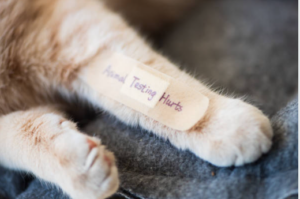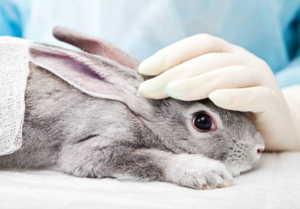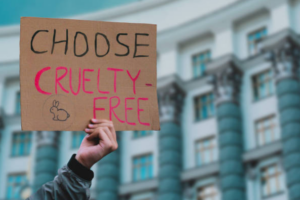Exploring the Current Landscape and Advocacy Efforts

In the world of beauty and cosmetics, the quest for perfection and innovation often takes center stage. However, this pursuit has historically come at the cost of animal welfare through the practice of animal testing. In Asia, a region renowned for its rich cultural heritage and growing beauty industry, the issue of animal testing remains a complex and contentious subject. This blog delves into the current landscape of animal testing in Asia, shedding light on the practices, regulations, and the dedicated efforts of advocates striving for change.
The State of Animal Testing in Asia
Animal testing, a practice that dates back decades, was once considered a necessary step to ensure the safety of cosmetics before they entered the market. However, as awareness about animal welfare and ethical concerns grew, so did the push for alternatives to these cruel and inhumane practices. The ethical dilemma of subjecting animals to pain, distress, and potentially harmful substances has become a focal point of discussion within the beauty industry.
At the forefront of the discussion about animal testing in Asia is China’s mandatory animal testing policy for imported cosmetics. Despite the global trend toward cruelty-free practices, China’s regulations require beauty products to undergo testing on animals before they can be approved for sale. This policy has drawn international criticism and raised questions about the compatibility of ethical beauty practices with a lucrative market.
Brands seeking access to the vast and lucrative Chinese market often find themselves facing a difficult decision: comply with animal testing requirements or forego a significant revenue stream. This conundrum exemplifies the tension between ethical considerations and business interests that shape the state of animal testing in Asia.
While China’s animal testing policy remains a significant challenge, it’s essential to recognize the progress being made in other Asian countries. Countries like India and Taiwan have taken bold steps by either banning or significantly restricting animal testing for cosmetics. These actions reflect a growing awareness of the ethical and scientific advancements that render animal testing unnecessary.
Japan and South Korea, two prominent players in the Asian beauty industry, have also made strides toward reducing animal testing. However, these efforts are met with a mix of praise and skepticism, as advocates continue to call for more comprehensive measures to fully eliminate these practices.
Advocacy Efforts and Positive Developments
Amidst the challenges posed by animal testing in the Asian beauty industry, a ray of hope shines through in the form of dedicated advocacy efforts and positive developments. A growing movement driven by organizations, activists, consumers, and even beauty brands themselves is transforming the landscape, gradually steering it toward cruelty-free practices. This section delves into the multifaceted realm of advocacy and the promising developments that are reshaping the industry’s approach to animal testing.
A significant driver of change is the increasing demand for cruelty-free products by consumers across Asia and around the world. Ethical consumerism has transcended beyond a mere trend, becoming a potent force that compels brands to reevaluate their testing methods. As more consumers become informed about the ethical implications of animal testing, they seek out brands that align with their values, ultimately leading to a surge in demand for cruelty-free alternatives.
This consumer-driven shift in preference has prompted beauty brands to reassess their approach to testing. Many brands are responding by developing cruelty-free product lines, while others are gradually transitioning their entire range to align with ethical standards. This shift not only benefits animals but also positions brands as leaders in responsible business practices, further enhancing their appeal to conscious consumers.

One of the most promising positive developments in the fight against animal testing is the rapid advancement of alternative testing methods. Scientific progress has paved the way for innovative technologies that offer accurate safety assessments without resorting to animal experimentation. These alternative methods include in vitro testing, computer modeling, and reconstructed human skin models, which provide reliable data while eliminating the need for animal subjects.
Advocacy organizations and beauty industry stakeholders are collaborating to champion the adoption of these alternative methods. By showcasing their effectiveness and reliability, they’re shifting the focus from archaic practices to cutting-edge solutions. The increasing acceptance and integration of these innovative approaches not only save countless animals from suffering but also enhance the accuracy and relevance of safety assessments.
Regulatory Changes and International Cooperation
In the ever-evolving landscape of the beauty industry, the issue of animal testing has garnered increased attention, sparking conversations and actions to address this ethical dilemma. One pivotal avenue in this journey toward ethical beauty practices lies in regulatory changes and international cooperation. These efforts are integral to reshaping the Asian beauty industry’s approach to animal testing, aligning it with global trends that prioritize cruelty-free and humane practices.
Regulatory changes play a significant role in shaping the landscape of animal testing in the Asian beauty industry. As awareness of the ethical concerns surrounding animal testing grows, several Asian countries have taken notable steps toward amending their regulations to reduce or eliminate animal testing for cosmetics.
Countries like India and Taiwan have emerged as trailblazers by imposing bans or stringent restrictions on animal testing. These actions signal a shift in mindset, indicating that governments are acknowledging the ethical and scientific advancements that render animal testing obsolete. As a result, brands operating in these countries are compelled to explore alternative testing methods and innovative approaches to product safety assessment.

Organizations like Humane Society International (HSI) have taken a leading role in advocating for international cooperation. By collaborating with governments, industry stakeholders, and scientists, HSI seeks to accelerate the transition to cruelty-free testing methods. Through workshops, training programs, and collaborative initiatives, HSI aims to build capacity and expertise in non-animal testing techniques, ensuring that these approaches become the standard across the beauty industry.
Education and Consumer Empowerment
In the age of information and conscientious consumerism, education has emerged as a powerful tool for driving change. When it comes to the realm of ethical beauty practices and the issue of animal testing in Asia, education plays a pivotal role in raising awareness, empowering consumers, and catalyzing a transformative shift in the industry. This section explores the critical intersection of education and consumer empowerment in reshaping the Asian beauty landscape.
The foundation of change lies in understanding. Educating individuals about the ethical implications of animal testing and the alternatives available is a crucial step toward igniting conversations and fostering a culture of compassion within the beauty industry. Advocacy organizations, academic institutions, and influencers are taking the lead in disseminating accurate information and debunking misconceptions surrounding animal testing.
Educational campaigns leverage various mediums, from social media platforms to seminars and workshops, to reach a wide audience. They provide insight into the pain and suffering animals endure during testing procedures, sparking empathy and prompting consumers to question the necessity of such practices. By shedding light on the realities of animal testing, education prompts a shift in mindset that aligns with cruelty-free and ethical beauty values.
Consumer choices wield immense power in influencing industry practices. As education spreads, consumers are empowered to make informed choices that reflect their values and beliefs. Ethical consumerism, driven by an understanding of the consequences of animal testing, prompts individuals to seek out brands that align with their ethical preferences.
In the digital age, influencers and advocates hold significant sway over consumer behavior and trends. These individuals utilize their platforms to amplify educational messages and advocate for ethical beauty practices. Influencers who embrace cruelty-free living and promote ethical brands inspire their followers to reconsider their own choices.
Advocacy organizations collaborate with influencers to create impactful campaigns that shed light on the realities of animal testing. By coupling emotional narratives with scientific facts, these campaigns engage audiences on a personal level, prompting them to question their beauty choices and encouraging them to support cruelty-free brands.
Educational efforts extend beyond individual consumers to shape beauty norms and industry standards. As education spreads, society begins to redefine beauty to include not only external appearance but also ethical values. The pressure to conform to outdated standards that prioritize physical beauty over compassion begins to wane, making room for an inclusive and conscious definition of beauty.

On an industry level, education encourages beauty brands to rethink their testing methods. Brands that align with ethical beauty values seek out alternative testing methods that prioritize the well-being of animals while ensuring product safety. As consumer demand for cruelty-free products grows, the beauty industry adapts to meet these expectations, ultimately creating a new standard for ethical beauty practices.
The issue of animal testing in the Asian beauty industry is complex and multifaceted, involving cultural, economic, and regulatory factors. However, the landscape is gradually shifting as advocacy efforts gain momentum, consumer preferences evolve, and innovative testing methods emerge.
As consumers, we hold the power to drive change through our choices. By supporting cruelty-free brands and demanding transparency, we send a strong message to the beauty industry that animal testing is no longer acceptable. The path toward ending animal testing in Asia is a journey of collaboration, education, and compassion – a journey that ultimately leads to a more beautiful world for humans and animals alike.

